Archived Storm Damage Blog Posts
Water Damage Protection in All Seasons | SERVPRO of Cookeville/Carthage/Smithville/Woodbury
11/17/2023 (Permalink)
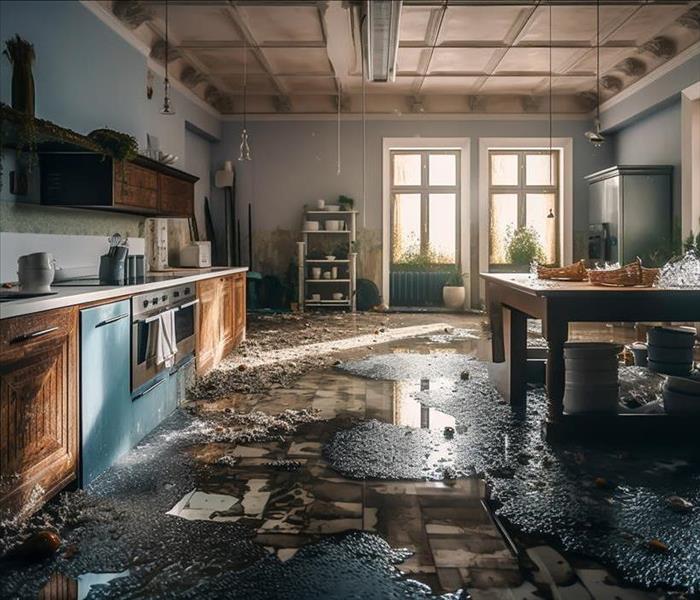 Is your home experiencing water damage? No worries, SERVPRO of Cookeville/Carthage/Smithville/Woodbury is here to help! Contact us today.
Is your home experiencing water damage? No worries, SERVPRO of Cookeville/Carthage/Smithville/Woodbury is here to help! Contact us today.
Water is one of the leading causes of home damage across the nation. It can strike year-round in a number of different ways, and it can even hide out long-term. Water moves quickly and creates compounded damage, too—making it a truly challenging disaster for a homeowner to deal with.
There are plenty of ways we can protect our homes from water damage, though. Even when it comes to natural disasters! You may not be able to prevent floodwaters, but you can prepare for them and mitigate your losses.
Each season, take some time to protect your home from water damage. Add a few things to your seasonal to-do list that can go a long way to keeping your home dry.
ur home
Spring and Summer
If you are a big spring-cleaner, you may not be super excited to add more to your to-do list for the season, but the good news is that protecting your home from water damage is actually pretty simple. There is also a good chance you are already doing a few of these housekeeping things, too.
Clean your gutters early in the spring in order to ensure rain can run through them easily. Make sure your downspouts are clear as well, and check around your home to ensure your landscaping slopes away.
Uncover your outside faucets in early spring and let some water run through them. Check for drips, unusual flow or any other issues so that you can correct it quickly.
During the summer, keep a close eye under your sinks and all around your bathrooms. With the addition of a high humidity in the weather outside, a small drip inside can quickly become a large mold problem. Check for musty smells, wet spots or slow drainage, which are all signs you could have a bigger problem.
If you are going on vacation over the summer, be sure to prepare your home ahead of your trip. Set your air to a steady temperature to avoid too much moisture inside, and consider having someone stop by every few days to walk-through your home so that you don’t come back to a surprise flood.
Fall and Winter
We may not talk about it as much, but fall cleaning is just as important as spring-cleaning in order to prevent damage during the cold season. Some of what you need to do to prevent water damage in the fall and winter is the same as spring and summer. Clean your gutters, check your downspouts and make sure your yard is in good shape.
Checking under sinks and around other water lines should be another piece of maintenance that you do year-round, but in the fall and winter, you want to pay particular attention to your pipes to prevent potential freezing. Make sure your pipes are well-insulated, allow them to drip when the temperatures take a dive and consider turning off the water to your outside faucets if you are able.
Take a look at the insulation in your attic during the fall and make sure there is enough—particularly in the corners. We do not see a lot of snow in our area during the winter, but ice is always possible. A well-insulated attic can help stop rainwater that may be on your roof or in your gutters from freezing, which will prevent water seeping in from the roof down.
Spend a little time each season protecting your home from water damage. With some simple home maintenance, you can avoid costly repairs.
Do you have water damage in your home? Contact us for fast restoration.
Protecting Your Home Against Wind Damage
9/6/2022 (Permalink)
Wind Damage from Different Types of Storms
While thunderstorms are the most common source of wind and storm damage, winds from hurricanes or tornadoes are more severe and may be more costly. Still, thunderstorms are responsible for a lot of damage, such as lightning, hail, tornadoes, straight-line winds, and flooding. Either way, billions of dollars are spent on wind damage repair and storm damage restoration each year. While understanding the nature of wind damage can’t stop them from happening, it can help you limit the amount of damage to your property and save on restoration and repair costs.
What You Need to Know
Flying Debris is a Damage Risk
Flying debris can cause more damage than strong winds themselves. Damage can result from plants or other unsecured structures and objects. If a storm is approaching your area, make sure any potential debris in your homes such as patio furniture, toys, garbage cans are either secured or brought inside. Bonus tip: For severe weather, secure your doors and windows, too.
A Well-Designed Roofing System Does Wonders
Apply roof deck, shingles, or membrane over the decking. A well-designed roofing system will anchor the trusses and decking to the walls and foundation to keep the entire roof from lifting off the structure in a strong wind. Roofing material should latch to the deck.
The construction phase of building a structure is the most influential piece in reducing damage caused by storms. Loosely connected shingles will lift from the deck, so fasten that siding down. Building codes will likely direct the minimum standards for connections. You, your architect, or your contractor may decide to exceed these minimums for a stronger storm-resistant structure—especially if you live in an area more prone to storms.
Monitor and Maintain Your Trees.
Falling trees and tree limbs are another significant type of damage to structures in a windstorm. Maintain your trees by removing dead limbs. In addition, remove the entire tree if it is dead. Healthy trees should have strong enough roots to withstand fairly strong winds, but dead trees will not.
Mitigating Damage After a Storm
What happens after the storm?
First, close any openings as soon as possible. Roof openings and broken windows are the most common source of water damage in these situations. Keep a roll of plastic sheeting that cuts to size and nail it over the opening. Your insurance policy will likely cover the cost of an emergency close-up, if needed, so contact your agent or claims center to report the damage and seek advice on how to proceed.
If the damage is too much to handle on your own, contact a restoration professional as soon as you can to help limit and repair damage and respond immediately to storm and flooding conditions.
Storm Damage v. Flood Damage: What's the Difference?
9/6/2022 (Permalink)
Property owners in Cookeville, TN, may have a hard time differentiating storm damage from flood damage—which is important when considering insurance coverage. Commercial properties can sustain water damage from both flood and storms, but there are a few significant differences to keep in mind that may help you manage these risks.
The most general distinction is that storm water comes from above, whereas flood water overspills natural bodies or watercourses and covers at least two acres of ordinarily dry land.
Storm damage to a commercial property may originate from a variety of causes such as:
- High winds
- Heavy rain
- Hurricanes
- Snow
- Tornadoes
Most business insurance plans protect from storm damage. Property owners need additional coverage to offset the expenses of flood damage. If your property is located on a flood plain, you should make sure you carry the policies necessary to protect your property investment.
Flooding occurs when water overflows a body of water or watercourse such as:
- Creeks
- Dams
- Lakes
- Storm-water channels
In order for water to be considered a flood, it must cover two acres and affect at least two properties.
If a commercial property is located in a high-risk zone, and the owner has a mortgage from an insured and federally-regulated lender, they must maintain flood insurance. Risks tied to flooding and storms should be known, minimized, and dealt with as soon as possible. Regardless of a moisture source, the risk of mold and other secondary damage within a building can be looming over the aftereffects of large, disastrous water events.
Restoring Damage From Storms and Floods
Restoration specialists can help property owners determine the precise causes of damage and the best solutions. If a property in Cookeville, TN, experiences flood damage or sustains damage during a storm, contact SERVPRO of Cookeville at (931) 528-9292 as soon as possible.
Deductibles and Storm Damage: Can You Claim Losses as Deductions?
7/29/2022 (Permalink)
Deductibles and Storm Damage
Storm damage can cause significant losses for a business. However, the answer to whether those losses are tax-deductible or not depends on several factors, the biggest of which is whether items or potential claims are insured. There is a term, casualty loss, which refers to the sudden or unexpected loss of something due to an unusual or sudden event. These losses can be deducted; however, there are several stipulations that may prevent you from using this deduction.
1. Reimbursable Items
You likely cannot claim a casualty loss deduction for items that are considered reimbursable, meaning items that are already insured and protected from loss. Therefore, anything covered under your commercial policy cannot be used as a deduction.
2. Routine Use or Neglect
Also, claiming storm damage loss for items that are already beyond their expected life or not adequately maintained will likely not be accepted as a deduction. For example, claiming an HVAC unit, which has been on the fritz with no routine maintenance checks, has unexpectedly failed due to a storm is not likely to pass muster.
3. Business Interruption
A casualty loss deduction also cannot be applied to projected future profits, meaning that if a storm causes business interruption, you cannot claim a loss on those profits you expected during the shutdown. The reason is due to actual loss and predicted loss. Deductions work by proving actual losses, meaning proven losses. Projections of future income are not proof of that income.
4. Restoration Work
Additionally, a casualty loss deduction will likely not encompass the costs of restoration work unless the work is not covered by your business policy. You can contact your insurer or a disaster restoration specialist in the Upper Cumberland, area to find out more information on coverage and payment options.
Storm damage is an unfortunate occurrence, but one that your business is hopefully protected against through adequate insurance coverage. If not, you may be able to claim a casualty loss deduction, but you will want to review the list above to ensure your deduction claim can make it through scrutiny.
How to Remove 2 Feet of Water From a Garage
7/29/2022 (Permalink)
Three Different Types of Pump That Can Remove Water From a Garage
There are several equipment options for extracting two feet of water from a commercial garage in Cookeville, TN. Learn about the differences between sump, trash, and truck-mounted pumps, and determine which of these three pump designs could be the best choice.
1. Sump Pump
A submersible industrial pump is a portable solution for removing flood water. These pumps draw water into a tank or container. Sump pumps can be ideal for commercial garages that are not convenient to access with a truck-mounted pump. These pumps may have bilge and ballast, centrifugal, or cantilever designs.
2. Trash Pump
Trash pumps are better suited for pumping up thicker liquids containing mud, silt, and debris than a sump pump or pump truck hoses. These pumps are typically heavy-duty centrifugal designs with deep impeller vanes and large discharge openings. A strainer on the end of the pump ensures that this equipment does not suck up debris that is much larger than leaves or twigs.
3. Truck-Mounted Pump
A pump truck is another portable solution for extracting standing water. This truck relies on industrial hoses to suck up water from a commercial garage or any other flooded location and transports this water to an appropriate disposal facility for black water from a flood. These pumps are particularly used for extreme flooding situations, and may be ideal for dealing with two or more feet of standing flood water.
These three pump solutions can remove standing water from a garage. The right pump depends on the accessibility and location of a garage as well as the quality of the flood water. While all flood water is considered Category Three black water, a large amount of debris or silt may call for a trash pump. Find out which pumping equipment is right for the job by scheduling a consultation with a storm damage restoration service in the Upper Cumberland.
Preparing for Fall Storms
9/3/2021 (Permalink)
If you know the Upper Cumberland area, it should come as no surprise that our area gets a heavy dose of annual rainfall, which is great to cool off from a hot, sticky day. However, it can also mean storm damage, water damage, and frequent flooding in your Cookeville home or business. To alleviate storm damage as the temperatures decrease, you have to take the appropriate measures to reduce and prevent further damage.
Storm Damage Checklist: Get The Scoop On Flood Remediation
- DO remove excess water by blotting and mopping affected areas.
- DO remove colored items from wet carpeting.
- DO gather and remove loose objects from wet areas and move to a safe place.
- DO place wood blocks and aluminum foil between wet carpets and furniture legs and prop all wet cushions.
- DON’T leave wet fabrics, furs, and leather goods lying around! Make sure to hang them up.
- DON’T use household appliances! This means not using your vacuum cleaner to remove water.
- DON’T turn on the ceiling fan if the ceiling is wet! This also includes staying away from rooms where the ceiling is sagging from excess water.
Further Cleanup: Electronic Restoration
- We know that water damage can cause a severe threat to your electronics. If you think that any of your electrical devices has been a victim of water damage, DO NOT attempt to turn them on!
- To prevent further corrosion and damage, we start the restoration process by cleaning up the exterior of all electronic devices.
- Electronics will be examined thoroughly by an experienced electronics technician afterward.
- We can handle anything from TV sets to computers and more!
It’s hard to predict the unpredictable, but a few practical measures and a call to SERVPRO of Cookeville can get you back on your feet after a storm in the Upper Cumberland. Contact us today at 931-528-9292. This franchise is independently owned and operated.
How To Handle Water Damage In Your Attic
9/3/2021 (Permalink)
Late summer in the Upper Cumberland means an influx of rainwater is rolling through town. These storms can severely impact your roof and spaces like your attic in your home. Water damage isn’t something to take lightly, and your attic is one of the places in your house that is most susceptible to water damage if your roof is in less than ideal repair. In the unfortunate event that you experience water damage in your attic, here’s what you should do next.
1. Figure out where the water is coming from.
First things first, always assess the water damage and try to determine where the water is coming into your attic. Figuring out where the water is coming from is key to preventing further damage and helps you realize what you should address first. Be sure to turn off the electricity before assessing the damage and touching anything electrical in the area! Water and electricity is never a good combination. The water damage may be more extensive than what meets the eye, so take careful notice of any water damage that is deeper than it may appear on the surface.
2. Stop the water leak(s).
Once you determine where the water is coming from, see if you can stop the water leak or call a professional to come and stop it as soon as possible. Take pictures of the leak and the damage for your home insurance carrier in the event that the damage goes beyond your deductible. These are essential for your claim to be approved and water damage to be minimized. You can reach the water damage restoration professionals at SERVPRO of Cookeville 24/7 for any emergencies at 931-528-9292.
3. Repair the damage.
Especially if there are any structural problems as a result of the water damage, your attic will need to be repaired in short order. Depending on the extent of the damage, you may need to hire professionals to repair structural, electrical, plumbing, or insulation damage. All of these types of attic damage affect your home beyond just the attic, which is why it’s integral to get them assessed and repaired.
Water damage in your attic requires attention and remedial action, and routinely checking your attic after it rains is a good practice to get in the habit of to minimize any potential damage that may come your way. If left unnoticed and unattended for a long time, water damage can severely alter the framework and livability of your home, which is why it should be adequately paid attention to. For help handling any water, fire, or storm damage as well as mold remediation and biohazard cleanup (including COVID-19 cleaning, sanitation, and disinfection services), contact SERVPRO of Cookeville at 931-528-9292. Our team is expertly trained and equipped with state-of-the-art technology to return your home or business to tip-top shape.
Retail Store Storm Damage & The Necessity of a Speedy Response
8/31/2021 (Permalink)
Severe weather such as storms and hurricanes can cause flooding that can devastate your retail store and interrupt business operations in just a few minutes. Depending on the extent of damage, you may need to close your business for several days or weeks to have the destruction repaired. Closing the doors can lead to a loss of revenue.
Acting quickly is crucial to avoid significant losses if you are dealing with commercial flood damage in your Cookeville retail store. Getting help from a remediation company can ensure that you get back to business quickly to avoid losing customers. Acting fast can also prevent mold infestation, which can sometimes cause effects to human health.
After flood water has entered your store, the loss of inventory will compromise your business operations. The stock in your store holds a large amount of capital. When you find ruined goods, you should immediately document the damage and the value of the products so that you can deduct the loss from your taxable income. Our team can help you separate the ruined inventory and document the damage for insurance claims purposes.
Even though it is not always possible to restore some flood-damaged merchandise, our crew can help you restore salvageable store fixtures and equipment. We can generally dry electronic equipment like computers and cash registers effectively. If the electronic equipment sustained damage, we also work with professionals who specialize in restoring electronic equipment.
Whatever the situation, our SERVPRO crew will develop a tailor-made plan to return your business to its preloss state.
We have the experience to restore commercial properties after flood damage. Using the latest flood damage restoration techniques and equipment, like high-pressure pumps, our crew can remove the water from your business premises. Our top of the line moisture detection equipment enables us to inspect for moisture in hard-to-reach areas like high ceilings. Our restorers are able to quickly assess large areas of the building to see how moisture traveled. We can then dry the structure using air moving and dehumidifying equipment. Our SERVPRO team can also clean and disinfect the affected area using professional grade cleaning and sanitizing agents to eliminate the contaminants that came in with the floodwater.
After experiencing flood damage in your Cookeville retail store, SERVPRO of Cookeville/Carthage/Smithville/Woodbury can help you get back to business by restoring the structure. Call us 24/7 at 931-528-9292 for a quick remediation process that can make the damage seem “Like it never even happened.”
How Winds Can Damage Your Home
8/31/2021 (Permalink)
High winds can damage your home
As high wind speed moves through the community, they can carry debris from homes and buildings, which can contribute to the widespread destruction of properties. It is for this reason that it is essential to put in place preventive measures to prevent high winds from incurring damages on your property. Read on to learn more about how much wind your home can withstand and ways to strengthen your home from high winds.
How Much Wind Can Your Home Withstand?
Even though all properties are truly unique in their own way, they all have relatively similar structural features that help them sway with the high winds. As storms have increased in severity in recent years, many building codes have been updated to ensure that properties of all sizes and classifications can withstand strong high winds, thereby decreasing the costs associated with storm damages.
According to the NOAA, hurricanes start at 74mph which are then classified by specific categories (1-5). For wind speeds weaker than 74 mph, you can still note these characteristics:
- 19mph: the swaying of small trees.
- 25mph: one cannot use the umbrella, and whistling of wires and branches can be heard.
- 32mph: difficulty when walking through the wind and swaying of the whole trees.
- 39mph: branches begin to break from trees, and vehicles veer on the road.
- 47mph: small structural damage.
- 55mph: wind begin to uproot trees, more structural damages.
- 64mph and up; most structural damage.
As you can see, it’s not until wind speeds top 47 mph that structural damage is likely to occur.
Ways to Strengthen Your Home From High Winds
If you want to rest easier when high winds blow through your neighborhood, then start with investing in modifications to your home that help reduce damage from heavy winds, such as pressure-rated windows. If you get the right pressure-rated windows, your property could be able to withstand wind gusts of up to 150 mph (Category 4 hurricane). Any doors that are leading to the outside should also be secured with three hinges and should be anchored to the door frame with a deadbolt.
Turning your home into a wind fortress may be extreme if you aren’t regularly forced to deal with strong winds. But that doesn’t mean that you shouldn’t take simple preventative measures to mitigate potential damage from the occasional heavy gusts.
Restoring Your Home Following High Wind Damage
Following a high wind severe storm has rolled through, assess your property from top to bottom to determine if any damages have occurred. No matter when you end up sustaining high wind damages to your property, you can trust SERVPRO of Cookeville to restore your property back to its pre-storm condition. Call us today at (931) 528-9292 to request a consultation!
Prepare Your Commercial Property for a Storm
6/14/2021 (Permalink)
Implement A Storm Preparedness Plan For Your Business
Storms can wreak havoc on commercial buildings. By implementing some sound storm preparedness plans you can reduce the risk of severe damage to your property in the Upper Cumberland.
1. Mitigate the Risks
Strong winds and heavy rain account for much of the damage during a storm. Before the storm hits, prepare your property to reduce the risk of extensive damage.
Bring in outdoor equipment, such as grills and lawn furniture to avoid items becoming airborne. Board up windows and glass doors so they don't shatter during the storm.
Inspect roofing materials to ensure they are secured. Fix any loose materials right away.
Trim any loose branches near the building so they don't damage the siding or break windows.
Disconnect computers and other electrical devices. Don't unplug the refrigerator, however.
Move loose items away from windows inside the building as much as possible.
2. Train Employees on Storm Procedures
Make sure all employees and visitors understand what to do in an emergency. Property management must develop work instructions to address the risks and then train workers on the procedures.
Conduct emergency drills with all employees so that they are familiar with the storm preparedness procedures. This will reduce the risk of people becoming panicked during a true emergency.
Designate evacuation exits and assign persons who are responsible to account for employees and visitors.
3. Inspect the Property After the Storm Passes
Wait until you are sure that the storm has passed before inspecting the building. If the emergency required persons to evacuate, don't allow employees to enter the building until authorities have given permission to do so.
Authorized personnel should inspect the property around the building to look for damage. They can identify issues to the structural integrity of the building and look for potential hazards that must be addressed. Call a storm restoration service if you need help with repairs.
Implement a sound storm preparedness plan to reduce the risk of damage during a storm.
3 Roof Repair Troubleshooting Tips
6/14/2021 (Permalink)
Three Types of Roof Damage You Could Be Dealing With
Whether you live on a beach with hurricanes or on a mountain with heavy winter snowstorms, your home can be at risk of sustaining wind damage. Because the roof is one of the most common places for it to happen, it is helpful to know how to quickly respond to problems there. Sometimes, you will need to call a storm damage remediation expert for help, but other times, you can fix things yourself. Here are three tips for recognizing the type of roof damage you are dealing with:
1. Check the Flashing
It is common for high winds to damage roof flashing in the Upper Cumberland. This is the material that protects the seams of roof fixtures such as your chimney. While you are checking the flashing, do not forget about the surrounding sealant. If it is old or cracked, you will need to replace it. Fortunately, this is an inexpensive kind of roof repair.
2. Look for Damaged Parts
A roof has several parts including vent boots, shingles and slits. Take time to carefully examine all of them. Damaged vent boots can lead to leaks, and it is easy for shingles to break and for slits to corrode. If any of this kind of roof damage occurs, you will need to buy replacement materials. This sort of roof repair can be more costly than flashing or sealant fixes, but it probably still will not break the bank.
3. Check for Holes
A puncture is one of the most expensive types of roof repairs you will encounter. If you notice a hole in your roof, moving quickly can save you money by reducing the amount of additional damage that may occur. Holes are not the kind of repair you want to make yourself though. Even if it can be costly, is better to leave this job to professionals.
If high winds damage your roof, it can be helpful to know what kind of roof repair you will need to make. Depending on the extent of the damage, you may be able to solve the problem yourself, or you made need professional assistance. Either way, acting quickly can reduce problems.
First Responders Face Unknown Hazards
9/14/2020 (Permalink)
When it comes to floods and other disasters, a first responder is like the pioneers in days of old. The pioneers blazed trails through new territory and made possible the Westward expansion. They explored the unknown reaches of our country, often at significant personal risk.
The first responders of today have a similar role. The difference is that they already know their destination. What they don’t know is the extent of the damage they will encounter. They don’t know what hazards they will face. They don’t even know if they can reach the problem areas. They may face many risks:
- Diseases brought by the flood
- Injury from debris, damaged buildings, live electric wires and gas leaks
- Animal encounters
First Responders Work Together as Teams
Teamwork is an essential part of a flood response strategy. When necessary, a first responder can summon additional support. Together, they remove obstructions, eliminate hazards and make the area safe. Once this is complete, homeowners may return to their homes.
Immunizations Are an Important Part of Personal Safety
Flooded areas are breeding zones for diseases. Because first responders are on the front lines of the flood recovery, they are the most susceptible to water-borne and insect-borne illnesses. They are also at higher risk from the inevitable cuts and scrapes that occur in the performance of their duties.
Immunizations are the best way to avoid these diseases. Emergency workers require protection from tetanus and hepatitis B. Individual response units and agencies may require their members to get protection from additional diseases such as typhoid or cholera.
It’s Time To Return to Your Home
Don’t forget to thank every first responder you encounter. They make it possible for you to return home and start the restoration. It’s helpful to know that there are disaster recovery specialists located in the Cookeville, TN, area ready to help restore your home. They are just a phone call away. When it’s over, it will be “Like it never even happened.”
Advice for Protecting Your Building From a Flood
8/31/2020 (Permalink)
Until it happens to you, the thought of becoming a victim of a flood seems remote. In reality, though, floods are among the most common disasters to strike a business, and the threat is only growing. Flood damage is a devastating situation for a company to deal with, but SERVPRO professionals in Cookeville, TN, can help you through the process. Aside from having proper flood insurance in place, partnering with a flood remediation team is one of the best ways to protect your company from rising waters. The team should operate on the principle "Faster to any size disaster" because speed is an important factor when it comes to minimizing the damage.
The Increasing Threat of Floods
With rising temperatures comes the threat of heavier rain events and the greater likelihood that a company will experience storm damage at some point. Floods can come in many levels of severity and from the following events:
- Torrential downpours
- Consistent rains over several days
- Hurricanes
- Saturated ground
- High tides coupled with higher sea levels
- High winds near lakes and oceans
The fact is, FEMA recently redrew the floodplain maps to reflect the greater threat of flooding. It might be a good idea to check to see if the floodplain map has changed in Carthage, TN.
The Best Protection
Flood damage is nothing to mess around with. It requires a fast response by professionals. The quicker a team arrives with powerful equipment the sooner it can begin the remediation process. It all begins with an inspection and an assessment of the problem, and then moves on to water removal. From there, the team can work on drying out the building to lessen the chance of mold gaining a foothold. Dry-cleaning may be used to clean and dry clothes, and then cleaning and sanitizing will take place.
Other techniques such as a tear out of damaged material may be needed. In the end, though, with the right remediation team, flood damage will look
"Like it never even happened."
What Types of Assistance Can You Expect From FEMA?
7/30/2020 (Permalink)
What Types of Assistance Can You Expect From FEMA?
When you're affected by heavy storm damage, you can get emergency help from the government through the Federal Emergency Management Agency. Financial assistance can be used to help you get back on your feet. Before getting into the services FEMA provides, take a look at who qualifies:
- Was your home damage a direct result of the storm?
- Is your home uninhabitable?
- Did you need to stay in a hotel because of power or water loss?
- Have you checked with your insurance provider?
- Do you live within a mandatory evacuation zone?
If your insurance company covers your losses, the agency won't pay for any covered costs for repairs or hotel bills.
Structural Repairs to Your Home
The grants from FEMA are intended to pay for minimal repairs that make it safe for you to live in your home. The financial assistance should go to the structural repairs your home needs. These repairs may include the foundation, walls, doors, cabinetry, and roof of your home, for example. If you aren't sure how much money you'll need, get an estimate from flood damage repair and recovery experts.
Temporary Housing
Sometimes, such as during Hurricane Harvey, it's not safe to remain in your home. Whether the dangers are related to power and water outages or structural damages, you may get help paying for a hotel room. If your insurance provides this type of cover during the flood, the agency won't cover the costs. If you do qualify, you'll need to find a hotel participating in the government's transitional housing program.
Medical Equipment
When you require a generator for medical devices, the government agency may reimburse you for the cost. To get this reimbursement, you must save your receipt and get a letter from your doctor. With this information, follow the registration process and wait to be contacted.
FEMA offers several services to help you out when flooding and other emergencies have made it impossible to remain in your Upper Cumberland home. Determine whether you qualify and then take the appropriate registration steps for financial assistance, loans, and reimbursement.
Flood Hazards for First Responders
7/30/2020 (Permalink)
When a flood hits Cookeville, TN, a first responder is the hero of the day as he or she works to protect lives, property and the environment. It is important for these trained professionals to look after themselves as well, and this work comes with its own set of potential risks. Rather than put yourself or others at risk, follow these simple steps to stay safe.
3 Steps You Should Follow to Stay Safe.
Safety Checklist
Flood response has its own set of hazards. Prior to heading out to help others, take time to review personal safety procedures.
- Immunizations for Hepatitis B and tetanus must be up-to-date.
- Protective clothing should include chemical-resistant outer clothing, goggles, boots and plastic or rubber gloves.
- Layer latex gloves over puncture-resistant gloves and discard them after use.
Other Precautions
After cleaning, don’t wear contaminated clothes in your personal vehicle. Remember to shower and change into uncontaminated clothes when your shift as a first responder ends. Wear a disposable N95 mask to protect yourself from inhaling mold. Clean wet surfaces with clean water and disinfectant. Properly vent portable generators and avoid the risk of electrocution.
More Protections
Be aware of your surroundings, especially when working near traffic. Watch for sinkholes and areas where the terrain has sustained damage. Seek medical care if you are exposed to raw sewage or chemicals. Frequently wash your hands in soap and clean water or with alcohol-based gel, especially before meals and after handling potentially contaminated materials.
The major cause of loss of life in floods is being trapped in a vehicle. It takes only a foot of water to float many cars and trucks, and once the wheels are off the road, rolling, flipping, or colliding with anything downstream can happen quickly.
A first responder is a welcome sight to flood victims and is the person who will lead the way to recovery and damage remediation. Though staying dry may be impossible, staying safe doesn’t have to be.
3 Safety Tips for Driving on Flooded Roads
5/29/2020 (Permalink)
Safety Tips To Keep In Mind To Ensure You Get Home Safely
Flooding in the Upper Cumberland can cause widespread damage to homes and other properties. However, few things are as fraught with danger than a flooded street. Water depth and swiftness can be difficult to gauge when driving and both can cause your vehicle to become trapped or swept away. If you encounter a flooded road while driving, there are a few safety tips you can keep in mind to ensure you get home safely.
1. Watch for Signs and Barriers
If strong thunderstorms have caused localized flooding, be aware of caution signs that alert drivers of dangerous areas. If you encounter a barrier across a flooded street, obey the posted signs that accompany it and turn around or follow any detour signs to avoid driving through the flooded area. Follow any directions flood damage and remediation service technicians give you if they happen to be working in the area.
2. Avoid Driving Through Standing Water
One of the most important travel tips to keep in mind while driving during a flash flood is to steer clear of standing water. This includes large puddles you might encounter in parking lots and highways. The depth of the water can be difficult to judge and could disable and damage your car if you try to drive through it. Flooded roads can also develop deep potholes and structural weaknesses that might cause you and your vehicle to become stranded.
3. Try to Reach Higher Ground
If you are driving on a road that starts to flood, try to drive in a direction that will take you to higher ground. If water levels start to rise, it is a good idea to pull over and move uphill on foot, away from flash flood waters, as your car’s tires may lose contact with the road if the water gets too deep.
Driving in the Upper Cumberland can be a challenge during heavy rain, especially when you encounter a flooded street. Knowing how to stay safe can help you reach your destination without injury or damage to your car.
Black Water 101: 4 Situations in Which You Need To Treat Flood Waters as a Health Hazard
5/29/2020 (Permalink)
If your business in the Upper Cumberland has recently experienced any flooding, you are likely already worried about the damage the water has caused to your building. However, you also need to be concerned about the safety of the water itself since flood water is often considered black water. This label is used to categorize contaminated water that poses a serious health hazard to anyone who comes into contact with it. If the flood was caused by any of the four following situations, get help immediately.
1. Sewage Leak
Sewage leaks due to issues with a septic tank or a burst sewer main can quickly lead to flooding and needs to be addressed immediately by a storm damage restoration specialist. It is important that the building is immediately evacuated and that any items contaminated by the water are not touched.
2. Toilet Backup
A toilet that is clogged or experiencing a backup can overflow and flood the bathroom before anyone is aware of what happened. Although you likely will be fine cleaning a small overflow yourself, a large-scale backup can post a health hazard. It is important to keep all customers and staff outside of the affected area.
3. Flooding From Outside
If flood water from outside (including water from overflowing rivers or streams) enters your building, you need to assume it is contaminated water. This is true even if you don’t know the source of the water or don’t identify any visible sewage.
4. Stagnant Water
If flooding occurs with your business, it can become black water if not quickly addressed. Water that stands in one place for an extended period of time can harbor harmful bacteria and become a serious health threat.
Although you might be eager to retrieve your items or enter your building to examine the damage, you will need to wait if you suspect the flood water might be contaminated. Remember to always leave the area and contact a professional when dealing with black water!
First Responders Face Unknown Hazards
9/10/2019 (Permalink)
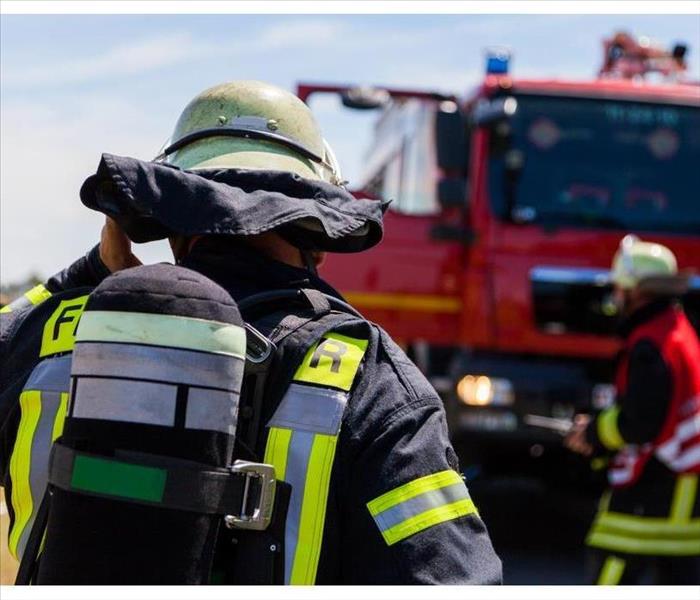 First responders work together as teams
First responders work together as teams
First Responders Face Unknown Hazards
When it comes to floods and other disasters, a first responder is like the pioneers in days of old. The pioneers blazed trails through new territory and made possible the Westward expansion. They explored the unknown reaches of our country, often at significant personal risk.
The first responders of today have a similar role. The difference is that they already know their destination. What they don’t know is the extent of the damage they will encounter. They don’t know what hazards they will face. They don’t even know if they can reach the problem areas. They may face many risks:
- Diseases brought by the flood
- Injury from debris, damaged buildings, live electric wires and gas leaks
- Animal encounters
First Responders Work Together as Teams
Teamwork is an essential part of a flood response strategy. When necessary, a first responder can summon additional support. Together, they remove obstructions, eliminate hazards and make the area safe. Once this is complete, homeowners may return to their homes.
Immunizations Are an Important Part of Personal Safety
Flooded areas are breeding zones for diseases. Because first responders are on the front lines of the flood recovery, they are the most susceptible to water-borne and insect-borne illnesses. They are also at higher risk from the inevitable cuts and scrapes that occur in the performance of their duties.
Immunizations are the best way to avoid these diseases. Emergency workers require protection from tetanus and hepatitis B. Individual response units and agencies may require their members to get protection from additional diseases such as typhoid or cholera.
It’s Time To Return to Your Home
Don’t forget to thank every first responder you encounter. They make it possible for you to return home and start the restoration. It’s helpful to know that there are disaster recovery specialists located in the Gordonsville, TN, area ready to help restore your home. They are just a phone call away. When it’s over, it will be “Like it never even happened.”
Advice for Protecting Your Building From a Flood
8/21/2019 (Permalink)
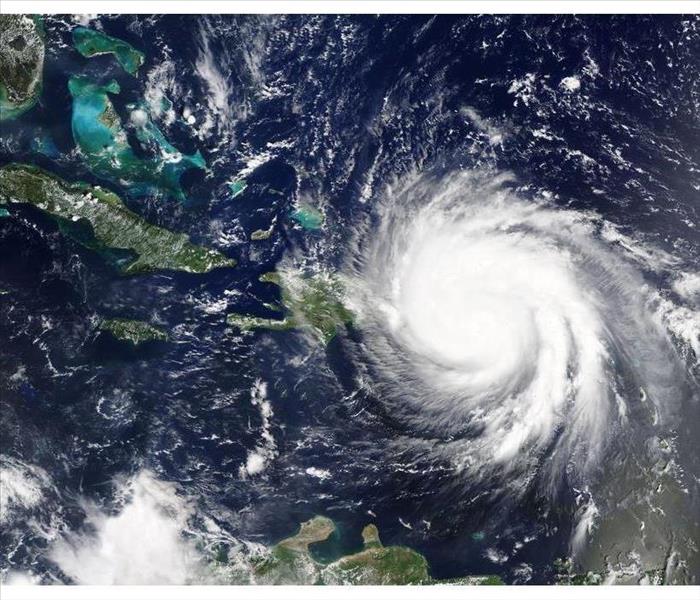 Floods can come from hurricanes
Floods can come from hurricanes
Until it happens to you, the thought of becoming a victim of a flood seems remote. In reality, though, floods are among the most common disasters to strike a business, and the threat is only growing. Flood damage is a devastating situation for a company to deal with, but professionals in Carthage, TN, can help you through the process. Aside from having proper flood insurance in place, partnering with a flood remediation team is one of the best ways to protect your company from rising waters. The team should operate on the principle Faster to any size disaster because speed is an important factor when it comes to minimizing the damage.
The Increasing Threat of Floods
With rising temperatures comes the threat of heavier rain events and the greater likelihood that a company will experience storm damage at some point. Floods can come in many levels of severity and from the following events:
- Torrential downpours
- Consistent rains over several days
- Hurricanes
- Saturated ground
- High tides coupled with higher sea levels
- High winds near lakes and oceans
The fact is, FEMA recently redrew the floodplain maps to reflect the greater threat of flooding. It might be a good idea to check to see if the floodplain map has changed in Carthage, TN.
The Best Protection
Flood damage is nothing to mess around with. It requires a fast response by professionals. The quicker a team arrives with powerful equipment the sooner it can begin the remediation process. It all begins with an inspection and an assessment of the problem, and then moves on to water removal. From there, the team can work on drying out the building to lessen the chance of mold gaining a foothold. Dry-cleaning may be used to clean and dry clothes, and then cleaning and sanitizing will take place.
Other techniques such as a tear out of damaged material may be needed. In the end, though, with the right remediation team, flood damage will look Like it never even happened.
Flood Hazards for First Responders
7/22/2019 (Permalink)
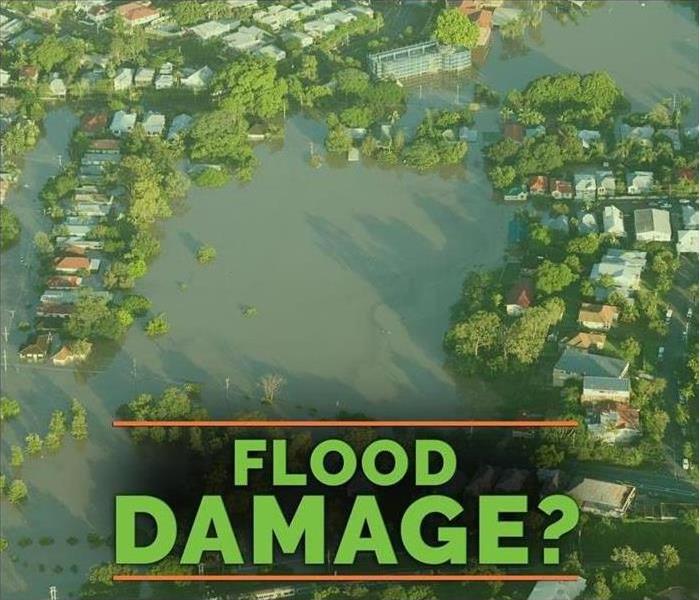 If suffering from storm damage follow these tips to stay safe
If suffering from storm damage follow these tips to stay safe
When a flood hits Cookeville, TN, a first responder is the hero of the day as he or she works to protect lives, property and the environment. It is important for these trained professionals to look after themselves as well, and this work comes with its own set of potential risks. Rather than put yourself or others at risk, follow these simple steps to stay safe.
3 Steps You Should Follow to Stay Safe.
Safety Checklist
Flood response has its own set of hazards. Prior to heading out to help others, take time to review personal safety procedures.
- Immunizations for Hepatitis B and tetanus must be up-to-date.
- Protective clothing should include chemical-resistant outer clothing, goggles, boots and plastic or rubber gloves.
- Layer latex gloves over puncture-resistant gloves and discard them after use.
Other Precautions
After cleaning, don’t wear contaminated clothes in your personal vehicle. Remember to shower and change into uncontaminated clothes when your shift as a first responder ends. Wear a disposable N95 mask to protect yourself from inhaling mold. Clean wet surfaces with clean water and disinfectant. Properly vent portable generators and avoid the risk of electrocution.
More Protections
Be aware of your surroundings, especially when working near traffic. Watch for sinkholes and areas where the terrain has sustained damage. Seek medical care if you are exposed to raw sewage or chemicals. Frequently wash your hands in soap and clean water or with alcohol-based gel, especially before meals and after handling potentially contaminated materials.
The major cause of loss of life in floods is being trapped in a vehicle. It takes only a foot of water to float many cars and trucks, and once the wheels are off the road, rolling, flipping, or colliding with anything downstream can happen quickly.
A first responder is a welcome sight to flood victims and is the person who will lead the way to recovery and damage remediation. Though staying dry may be impossible, staying safe doesn’t have to be.
What Types of Assistance Can You Expect From FEMA?
7/18/2019 (Permalink)
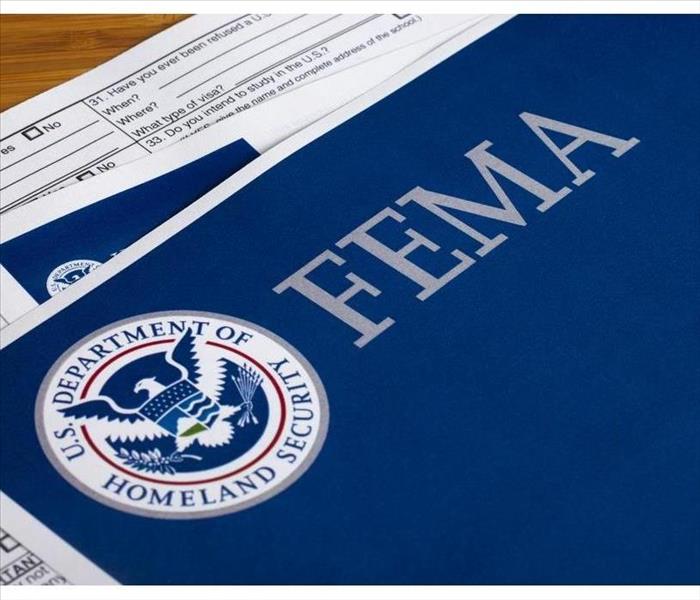 Federal Emergency Management Agency
Federal Emergency Management Agency
What Types of Assistance Can You Expect From FEMA?
When you're affected by heavy storm damage, you can get emergency help from the government through the Federal Emergency Management Agency. Financial assistance can be used to help you get back on your feet. Before getting into the services FEMA provides, take a look at who qualifies:
- Was your home damage a direct result of the storm?
- Is your home uninhabitable?
- Did you need to stay in a hotel because of power or water loss?
- Have you checked with your insurance provider?
- Do you live within a mandatory evacuation zone?
If your insurance company covers your losses, the agency won't pay for any covered costs for repairs or hotel bills.
Structural Repairs to Your Home
The grants from FEMA are intended to pay for minimal repairs that make it safe for you to live in your home. The financial assistance should go to the structural repairs your home needs. These repairs may include the foundation, walls, doors, cabinetry, and roof of your home, for example. If you aren't sure how much money you'll need, get an estimate from flood damage repair and recovery experts.
Temporary Housing
Sometimes, such as during Hurricane Harvey, it's not safe to remain in your home. Whether the dangers are related to power and water outages or structural damages, you may get help paying for a hotel room. If your insurance provides this type of cover during the flood, the agency won't cover the costs. If you do qualify, you'll need to find a hotel participating in the government's transitional housing program.
Medical Equipment
When you require a generator for medical devices, the government agency may reimburse you for the cost. To get this reimbursement, you must save your receipt and get a letter from your doctor. With this information, follow the registration process and wait to be contacted.
FEMA offers several services to help you out when flooding and other emergencies have made it impossible to remain in your Algood, TN, home. Determine whether you qualify and then take the appropriate registration steps for financial assistance, loans, and reimbursement.
Is All Flood Water Contaminated Black Water?
5/8/2019 (Permalink)
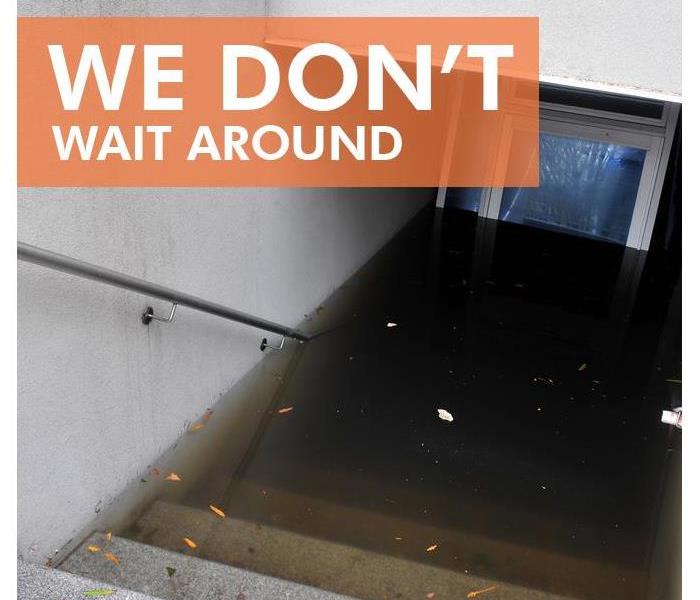 Flooding and water emergencies don't wait for regular business hours
Flooding and water emergencies don't wait for regular business hours
Restoration professionals classify flood water as Category Three water damage. The categories used to describe damage are based on the level of contamination present in water. Learn more about the conditions that tend to cause black water to accumulate during a flood.
Water Sources
The cause of a flood determines the initial level of contamination. There are several common sources of flood water:
- Heavy rains
- Rising bodies of surface water
- Storm surges
- Sewer backups
Even if this flooding starts as Category Two gray water that does not contain solid waste, contamination can occur as soon as the water travels over land or stands for hours or days. Damage caused by contaminated water must be cleaned, disinfected and dried.
Courses or Paths
Water may accumulate contaminants as it travels through an area. In addition to solid waste, which may be introduced from an overflowing municipal main, this water could also carry other substances that can pose health or safety risks:
- Chemicals
- Heavy metals
- Microbes
Depending on where flooding originates and where standing water accumulates, different types of contamination may or may not be present. It is advisable to disinfect any areas exposed to flooding.
Standing Water
Regardless of the initial level of contamination in water, standing water will degrade and become more contaminated over time. Within a matter of days, clean, treated Category One water from a pipe break can degrade into Category Two and eventually Category Three water damage. Damage mitigation and restoration experts recommend timely extraction, cleaning, disinfection and drying.
There are a number of ways in which flood water may become contaminated. If there is a reasonable possibility that water may contain solid waste, any damage it causes will be classified as Category Three damage. If flooding has damaged a commercial building in Cookeville, TN, the property owner or manager should arrange for storm damage mitigation and restoration.
Bathub Sewage 101
4/25/2019 (Permalink)
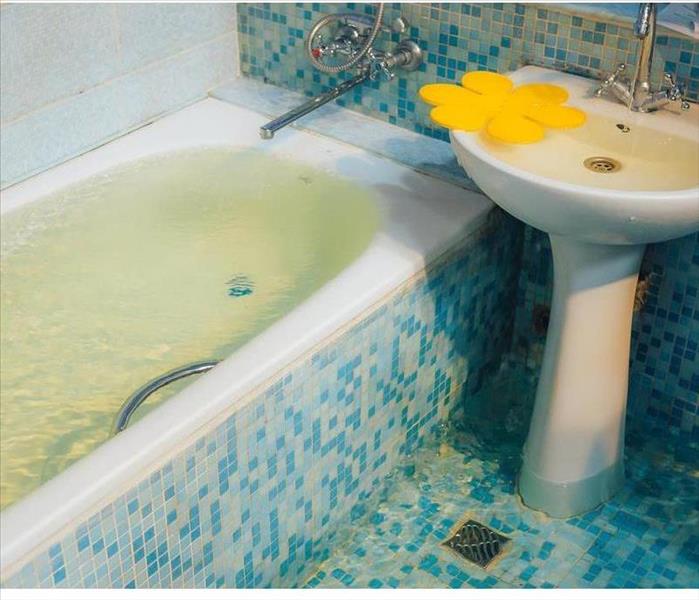 A sewer backup can be quite unpleasant - especially when it occurs in your bathtub, you will need to take care of this issue as soon as possible.
A sewer backup can be quite unpleasant - especially when it occurs in your bathtub, you will need to take care of this issue as soon as possible.
A sewer backup can be quite unpleasant - especially when it occurs in your bathtub. If you are suffering from this type of sewage, you probably want to take care of the issue as soon as possible. However, there are times that it makes sense to fix the backup yourself and times when expert help is needed. Here’s how to figure out which situation you are dealing with.
Do-It-Yourself Scenarios
If the bathtub backup is small and did not cause extensive damage - and you have the proper protective gear and equipment - you can attempt to begin cleanup yourself. Here are some tips to remember during the process:
- If you are dealing with flooding, do not run your air conditioner or heating system.
- Throw away any non-essential items ruined by the sewer backup and keep them away from clean areas.
- Move clean items into a clean space as soon as possible.
- Open your doors and windows if it is sunny and dry outside.
- Try to learn techniques to prevent future backups, with or without professional assistance.
If you run into a bigger issue at any point during cleanup, remember to call a plumber, cleanup service or other professional for help.
Expert Help Scenarios
There are certain cases that call for professional assistance no matter what. If you are facing a huge flood, extensive damage or a massive backup, a professional water damage restoration company in Baxter, TN, should be called to help with cleanup tasks. You may also need to talk to other experts to handle specific issues that arise.
Final Advice
When it comes to a sewer backup, you want to use all of the resources available to you to get your bathroom back in clean, usable shape as soon as possible. It can be hard to ask for help, but assistance and investment are both worth the end result of a safe and secure home.
Black Water 101: 4 Situations in Which You Need To Treat Flood Waters as a Health Hazard
2/14/2019 (Permalink)
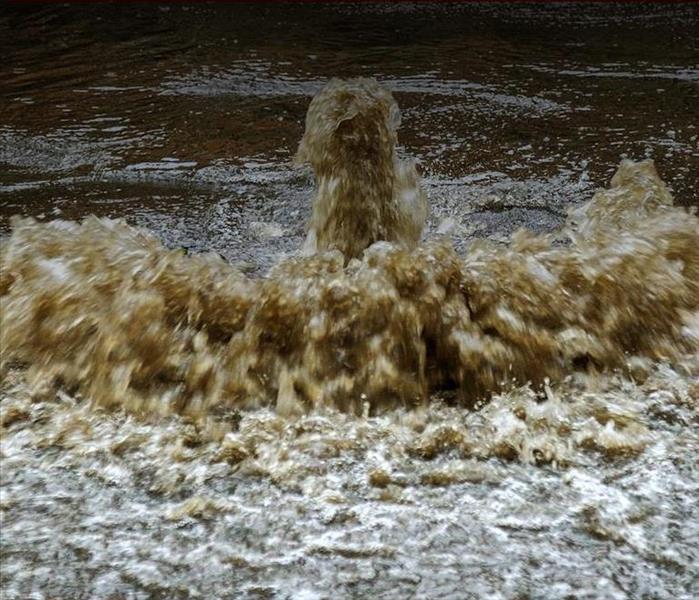 Contact SERVPRO when dealing with black water.
Contact SERVPRO when dealing with black water.
Flood Waters often Considered Black Water
If your business in Cookeville, TN, has recently experienced any flooding, you are likely already worried about the damage the water has caused to your building. However, you also need to be concerned about the safety of the water itself since flood water is often considered black water. This label is used to categorize contaminated water that poses a serious health hazard to anyone who comes into contact with it. If the flood was caused by any of the four following situations, get help immediately.
1. Sewage Leak
Sewage leaks due to issues with a septic tank or a burst sewer main can quickly lead to a flooding and needs to be addressed immediately by a storm damage restoration specialist. It is important that the building is immediately evacuated and that any items contaminated by the water are not touched.
2. Toilet Backup
A toilet that is clogged or experiencing a backup can overflow and flood the bathroom before anyone is aware of what happened. Although you likely will be fine cleaning a small overflow yourself, a large-scale backup can post a health hazard. It is important to keep all customers and staff outside of the affected area.
3. Flooding From Outside
If flood water from outside, including water from overflowing rivers or streams, enter your building, you need to assume it is contaminated water. This is true even if you don’t know the source of the water or don’t identify any visible sewage.
4. Stagnant Water
If flooding occurs with your business, it can become black water if not quickly addressed. Water that stands in one place for an extended period of time can harbor harmful bacteria and become a serious health threat.
Although you might be eager to retrieve your items or enter your building to examine the damage, you will need to wait if you suspect the flood water might be contaminated. Remember to always leave the area and contact a professional when dealing with black water!
Understanding Fungus: Mold and Mildew After a Storm
1/22/2019 (Permalink)
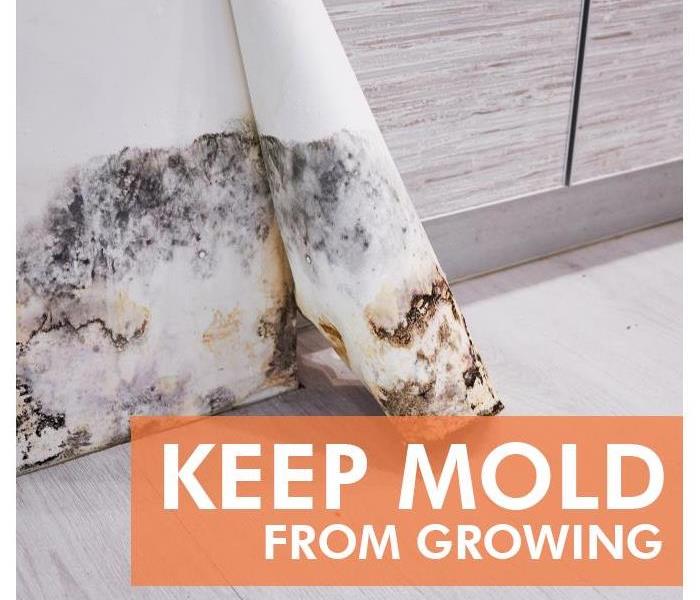 Avoid mold damage in your Cookeville, TN home
Avoid mold damage in your Cookeville, TN home
The Difference Between Mold And Mildew
Mold damage may be one of the greatest fears for any homeowner. An infestation can cause thousands in damage, and if a result of lingering issues, homeowners’ insurance may not cover the costs. While it is a fear, most don’t understand the difference between mold and mildew. One is hard to remedy, possibly requiring a specialist, and the other is a simple fix, likely resolved with a store-bought cleaner.
1. Size
Mildew growth can be subtle, often manifesting in small areas and only on the surface. Mold, on the other hand, is more predominant, and when it appears on the surface of a wall, you likely have a more significant issue in the wall cavity.
2. Color
When you encounter actual mold growth and mold damage, the color can be a dead giveaway as to whether it is mildew or mold. Mold is typically black and green. However, it may even be shades of blue and yellow, depending on the surfaces it has invaded. Mildew generally is only one of two colors, either gray or white.
3. Texture
The most apparent difference between mold and mildew is the texture. Mold is overall more textured and is likely fuzzy in appearance. Mildew is flat and appears as more of a stain than a growth.
4. Spread
While both mold and mildew spread quickly, mildew, as a surface fungus, tends to be a little more manageable. Mold, because of its nature, often develops in areas that are not easily visible, meaning that when it is discovered, it is more of an infestation. If you find mold, there is likely more lurking behind drywall and under floorboards. In most cases, you may need a mold remediation specialist in the Cookeville, TN, area to asses the damage.
Mold damage is no laughing matter, and it can lead to many problems if not handled properly. However, not every fungal growth is mold. Mildew is a manageable growth that can be resolved with basic household cleaners.
After a Flood: What Not To Do
9/18/2018 (Permalink)
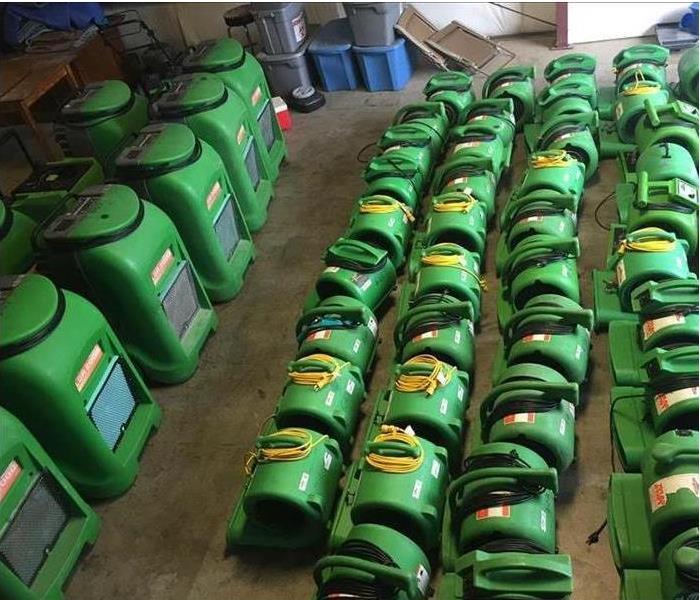 Equipment ready for any storm damage in Carthage, TN
Equipment ready for any storm damage in Carthage, TN
If your home in Carthage, TN, is plagued by flood water, you will undoubtedly get a lot of advice about what to do to make the recovery process smoother. Avoiding unnecessary or harmful behavior, however, is just as important, if not more so, than taking positive steps. Here are five actions to avoid so that you don't make a situation that's potentially dangerous worse for you and your family.
1. Don't Stay.
Step one of dealing with a flooded home is getting out of it. Don't try to stay in your house, especially if you have significant damage or if evacuation is recommended or mandated. You could be putting your family's safety at risk.
2. Don't Wade.
A number of problems could arise from standing flood water. It could be charged with electricity, hiding sharp or dangerous items or filled with bacteria. At any rate, you don't want this water to touch your skin or be anywhere near you.
3. Don't Play.
If you are waiting to be rescued or waiting on an adjuster to arrive, you may feel bored. Fight the urge to play games on your phone or use it in any way that depletes the charge. You may need it for emergency reasons, and you may not have any place to recharge it.
4. Don't Buy.
Purchasing new furniture or replacing destroyed items is the very last item on the restoration to-do list. Buying these things before you have a clean, restored place to put them is inadvisable.
5. Don't Hesitate.
You may see widespread water damage all around you, but don't assume that your insurance company and flood restoration specialists won't have time to come and assess your property. Go ahead and give them a call to report the damage to your home. The sooner you call, the sooner they can help.
Flood water in your home is a situation that calls for smart action. Take the steps you need to take, and avoid the things that work against you.
How To Train Employees on Evacuation Protocol
8/21/2018 (Permalink)
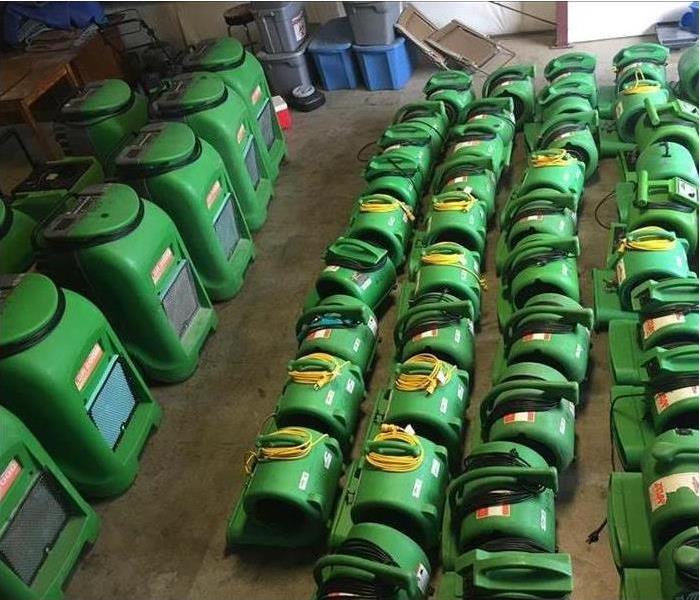 Storm equipment in Smithville, TN
Storm equipment in Smithville, TN
As a business owner in Smithville, TN, your goal is usually to keep your employees at work, not to teach them to get out. However, in the event of a real emergency, or planned fire drill, getting out is exactly what you need them to do. Review the tips below to put a preparedness plan into place to keep you and your staff safe in a disaster.
What To Do Before an Evacuation Drill
Prior to tripping the smoke alarm and expecting an efficient fire drill to occur, you must plan and train your staff accordingly.
- Create an emergency action plan. Include primary and secondary escape routes and assign responsibilities, such as shutting down hazardous materials equipment or calling 911. Specific roles and responsibilities vary by the type of business and building.
- Train staff on how to recognize the alarm, and ensure that it can be seen, heard and/or felt by all personnel. Plan for employees with disabilities.
- Communicate both verbally and in writing a clear policy and procedure related to evacuation. Provide each person a copy or post throughout the building.
What To Do After a Drill
Your employees are out of the building safely. Now what?
- Even in a drill, account for all employees. Set a specific meeting place for each employee and assign someone to check all names against a predetermined list. In an actual disaster, knowing if someone is still inside the building is critical.
- Repeat the drill often so that your staff can easily perform the steps quickly under pressure. Practicing is especially important at onset, when new employees join and when changes are made to the business or the plan.
- Evaluate the effectiveness of each drill, so continual improvements can be made.
Whether you are conducting a fire drill, or experiencing a real emergency at your business in Smithville, TN, the goal is to get your employees out safely. If a disaster should occur, once everyone is safe, conduct a visual damage check of your commercial property. If damage is present, contact a storm restoration specialist and your insurance agent as soon as possible.
How Do I Plan an Emergency Escape Drill for My Business?
6/14/2018 (Permalink)
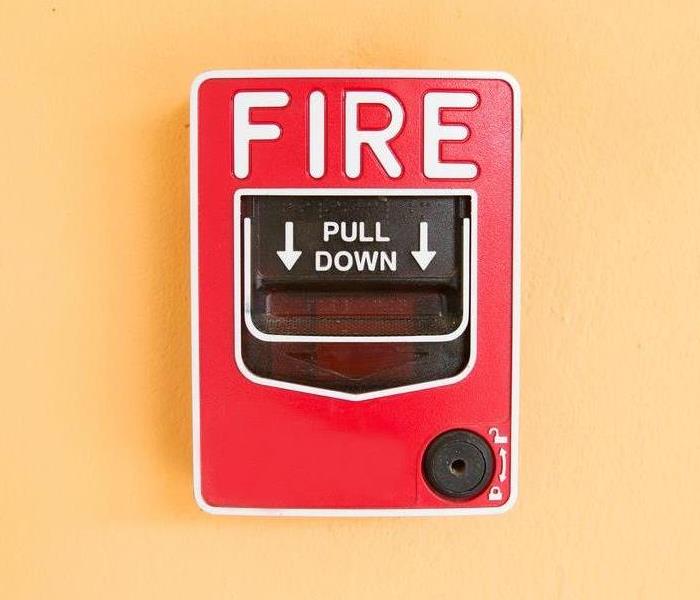 Trigger your fire or disaster alert system’s test or drill programs at random intervals.
Trigger your fire or disaster alert system’s test or drill programs at random intervals.
Having an emergency escape plan in place for your business is a critical part of workplace safety. Not only does it protect your employees, but it protects your customers. But how do you create an effective escape drill or fire drill for your Cookeville, TN, business?
Know Your Escape Points
You should map out every safe escape point in your building. This can include:
• Exterior doors
• Employee exits
• Stairwells
• Windows
Every floor should have its own accessible escape points. Make sure your escape plan includes these access points. Educate employees on their locations and proximity to various areas, so that no matter where employees are they can reach the closest safe exit – and shepherd customers as needed. Employees should also be able to quickly remember alternative safe exit points in the event their closest exit is blocked off or dangerous.
Hold Safety Seminars
Employees need to know the routine for a fire drill or evacuation before they can practice it. Hold safety seminars teaching them the important details and safe pathways, and do multiple practice runs during these seminars. Answer any questions that may arise to help your employees understand.
Designate Evacuation Leaders
Multiple employees per shift should be designated and trained to act as evacuation leaders, guiding others in the event of a crisis. During your drills, activate your evacuation leaders to test their responses and their knowledge of safe escape routes.
Use Random Testing
Trigger your fire or disaster alert system’s test or drill programs at random intervals. You should also have planned, scheduled fire drills to help employees practice, but random drills will help them memorize exactly how they should be responding in the event of a real crisis. Make sure not to actively trigger a real alert, though, as sometimes this can initiate a response by emergency services. If you’re not sure how to conduct a test/drill run, speak with your fire and emergency system installer to gain more insight. For more information, visit http://www.SERVPROcookevillecarthagesmithvillewoodbury.com/.
 Is your home experiencing water damage? No worries, SERVPRO of Cookeville/Carthage/Smithville/Woodbury is here to help! Contact us today.
Is your home experiencing water damage? No worries, SERVPRO of Cookeville/Carthage/Smithville/Woodbury is here to help! Contact us today.





 24/7 Emergency Service
24/7 Emergency Service










